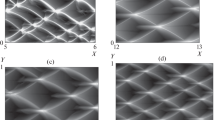Abstract
This paper describes the results of a numerical study pertaining to the interruption of detonation wave propagation in monofuel–air mixtures by a layer of inhomogeneous inert particles. It is shown that layer diameter, layer length, and the inhomogeneity of inert particles affect this process. It is revealed that, if the total mass of the mixture is fixed, a layer with a linearly decreasing concentration of inert particles damps detonation waves much better than that with a linearly increasing and uniform concentration of inert particles.










Similar content being viewed by others
REFERENCES
A. V. Fedorov, D. A. Tropin, and I. A. Bedarev, “Mathematical Modeling of Detonation Suppression in a Hydrogen–Oxygen Mixture by Inert Particles," Fiz. Goreniya Vzryva 46 (3), 103–115 (2010) [Combust., Expl., Shock Waves 46 (3), 332–343 (2010)].
A. V. Fedorov and D. A. Tropin, “Determination of the Critical Size of a Particle Cloud Necessary for Suppression of Gas Detonation," Fiz. Goreniya Vzryva 47 (4), 100–108 (2011) [Combust., Expl., Shock Waves 47 (4), 464–472 (2011)].
P. A. Fomin and J.-R. Chen, “Effect of Chemically Inert Particles on Thermodynamic Characteristics and Detonation of a Combustible Gas," Combust. Sci. Technol. 181 (8), 1038–1064 (2009); DOI: 10.1080/00102200902908535.
M. V. Papalexandris, “Numerical Simulation of Detonations in Mixtures of Gases and Solid Particles," J. Fluid Mech. 507, 95–142 (2004); DOI: 10.1017/S0022112004008894.
Z. Chen, B. Fan, and X. Jiang, “Suppression Effects of Powder Suppressants on the Explosions of Oxyhydrogen Gas," J. Loss Prev. Process Ind. 19 (6), 648–655 (2006); DOI: 10.1016/j.jlp.2006.03.006.
G. Dong, B. Fan, B. Xie, and J. Ye, “Experimental Investigation and Numerical Validation of Explosion Suppression by Inert Particles in Large-Scale Duct," Proc. Combust. Inst. 30 (2), 2361–2368 (2005); DOI: 10.1016/j.proci.2004.07.046.
K. C. Gottiparthi and S. Menon, “A Study of Interaction of Clouds of Inert Particles with Detonation in Gases," Combust. Sci. Technol. 184 (3), 406–433 (2012); DOI: 10.1080/00102202.2011.641627.
Y. Liu, X. Liu, and X. Li, “Numerical Investigation of Hydrogen Detonation Suppression with Inert Particle in Pipelines," Int. J. Hydrogen Energy 41 (46), 21548–21563 (2016); DOI: 10.1016/j.ijhydene.2016.09.170.
H. Shafiee and M. H. Djavareshkian, “CFD Simulation of Particles Effects on Characteristics of Detonation," Int. J. Comput. Theory Eng. 6 (6), 466–471 (2014); DOI: 10.7763/IJCTE.2014.V6.911.
D. A. Tropin and A. V. Fedorov, “Physical and Mathematical Modeling of Interaction of Detonation Waves in Mixtures of Hydrogen, Methane, Silane, and Oxidizer with Clouds of Inert Micro- and Nanoparticles," Combust. Sci. Technol. 191 (2), 275–283 (2019); DOI: 10.1080/00102202.2018.1459584.
D. A. Tropin and A. V. Fedorov, “Mathematical Modeling of Detonation Wave Suppression by Cloud of Chemically Inert Solid Particles," Combust. Sci. Technol. 186 (10/11), 1690–1698 (2014); DOI: 10.1080/00102202.2014.935637.
A. G. Kutushev, Mathematical Modeling of Wave Processes in Air–Particle and Powder-Like Media (Nedra, St. Petersburg, 2003) [in Russian].
A. G. Kutushev and O. N. Pichugin, “Numerical Investigation of the Process of Interrupting the Detonation Wave Propagation in Monofuel Gas Suspensions Using an Inert Particle Layer," Fiz. Goreniya Vzryva 29 (2), 90–98 (1993) [Combust., Expl., Shock Waves 29 (2), 215–222 (1993)].
A. G. Kutushev and O. N. Pichugin, “Influence of the Spatial Nonuniformity of Particle Distribution in a Screening Layer on the Suppression of a Detonation Wave in a Monofuel–Air Suspension," Fiz. Goreniya Vzryva 32 (4), 107–109 (1996) [Combust., Expl., Shock Waves 32 (4), 449–451 (1996)].
B. Kh. Khuzhaerov, A. G. Kutushev, V. F. Burnashev, and U. A. Nazarov, “Numerical Simulation of Interruption of Detonation Wave Propagation in Monofuel–Gas Mixtures by a Layer of Inert Particles," Probl. Mekh., No. 1, 31–35 (2010).
R. I. Nigmatulin, Dynamics of Multiphase Media (Nauka, Moscow, 1982; Hemisphere, New York, 1991).
O. M. Belotserkovskii and Yu. M. Davydov, Large Particle Method in Gas Dynamics (Nauka, Moscow, 1982) [in Russian].
Author information
Authors and Affiliations
Corresponding author
Additional information
Translated from Fizika Goreniya i Vzryva, 2021, Vol. 57, No. 6, pp. 65-76.https://doi.org/10.15372/FGV20210608.
Rights and permissions
About this article
Cite this article
Nazarov, U.A. Interruption of Detonation Wave Propagation in Monofuel–Air Mixtures by a Layer of Inhomogeneous Inert Particles. Combust Explos Shock Waves 57, 693–703 (2021). https://doi.org/10.1134/S0010508221060083
Received:
Revised:
Accepted:
Published:
Issue Date:
DOI: https://doi.org/10.1134/S0010508221060083




